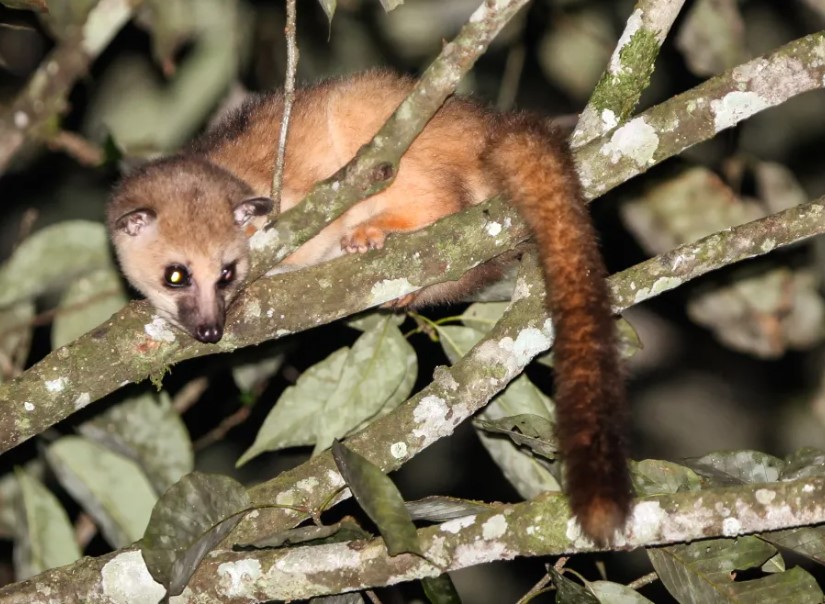
Reissued: Java 2010
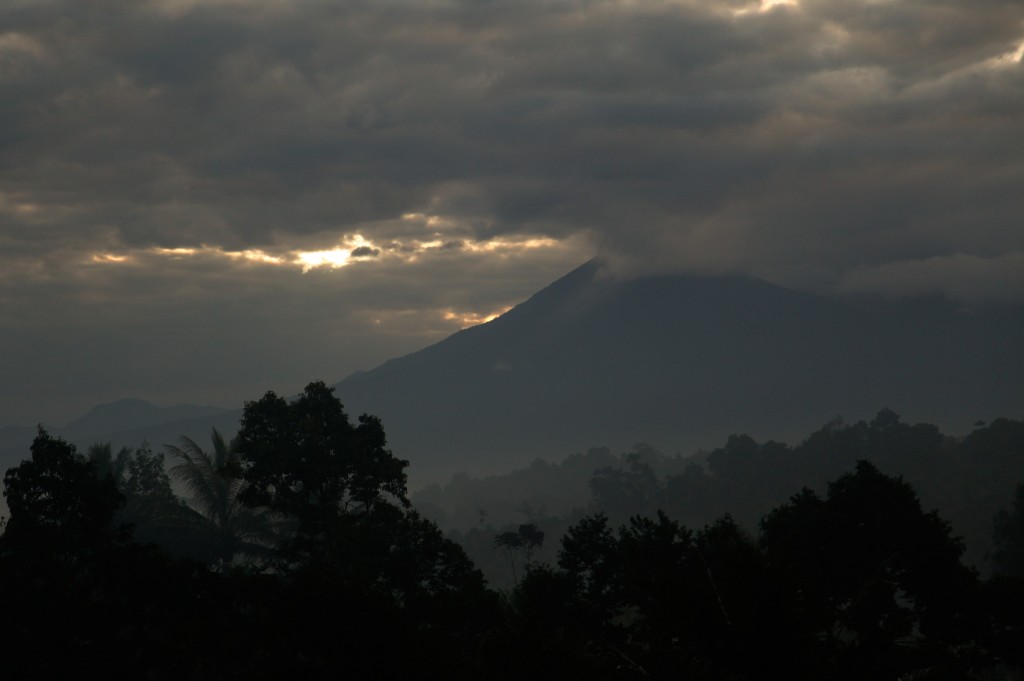
I visited Indonesia for the first time in June 2010 and after a meeting in Jakarta I had a few free days before leaving for New Caledonia. I couldn’t find much info at all on mammal watching in Indonesia and decided to confine my first visit to Java.
I only had a few days so I contacted Indra and Panca at IF-Ecoadventure to see what they could do. They primarily run birding tours and were honest that they didn’t know a great deal about the mammals. But they did know where to see some things and promised to try hard to find the things I wanted to see and we arranged to visit two national parks: Gunung Gede and Gunung Halimun.
Although IF-Ecoadventure arranged the trip well, and I was happy with the guiding in particular, the trip was expensive and I guess it cost at least twice what it would have cost me to have organised myself. For most of the trip I was based at Gunung Gede, staying in Indra’s father’s guest house – Freddy’s Homestay – and using Indra’s brother Eddy as a guide, and so in fact there was not a great deal of arranging to be done.
I would consider using the company again, but next time I would ask for a lot more detail on what was included for the price and perhaps use them only for the more complicated segments of a trip.
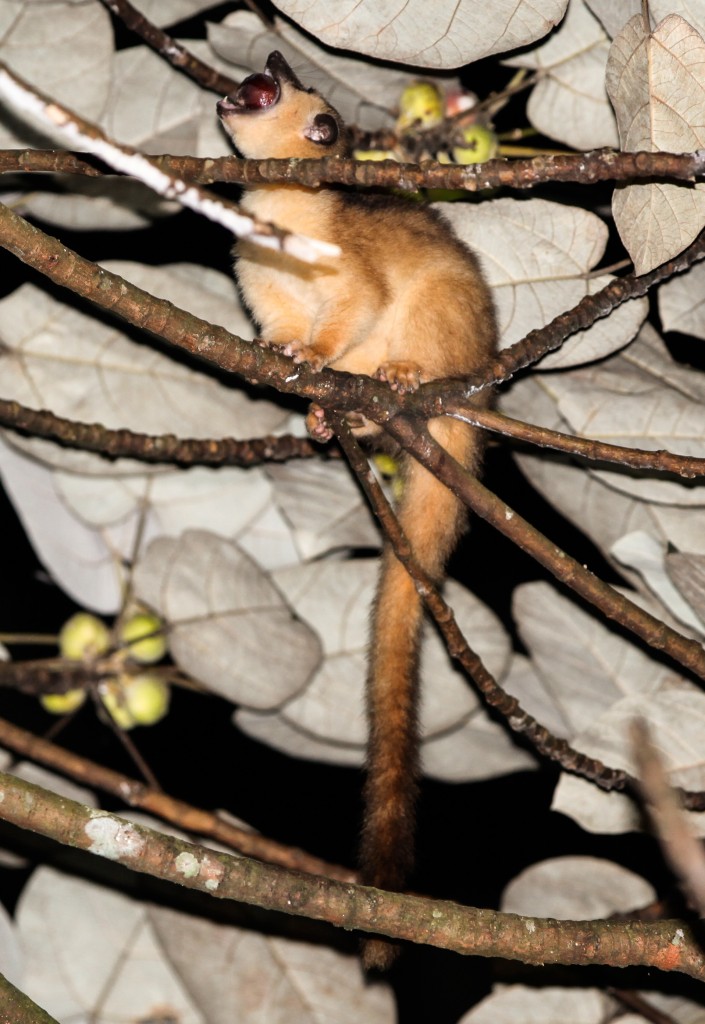
Javan Small-toothed Palm Civet, Arctogalidia trivirgata trilineata
Eddy, my guide in Gunung Gede, was particularly committed and I’d recommend him. He is mainly a birder but he was good at finding mammals and found most of what I was looking for and worked hard to do it. Eddy can be contacted via Freddy’s Homestay in Cibodas (they are in the Lonely Planet and probably best contacted by checking on Google). Indra accompanied me to Gunung Halimun and he knows the park well.
I couldn’t find a field guide to Java, or even a list of the mammals for the island. I used Charles Francis’s “A photographic guide to the mammals of S.E. Asia”, which was better than nothing and covers Java but many of the species aren’t included (mainly those species that you need a field guide to ID unfortunately!). I also had his more comprehensive “Field Guide to the Mammals of S.E. Asia” which sadly doesn’t cover Java but of course there is some overlap.
The weather in July ought to be dry, but we had rain most days, usually off and on from 5 p.m.-9 p.m.
Gunung Gede National Park
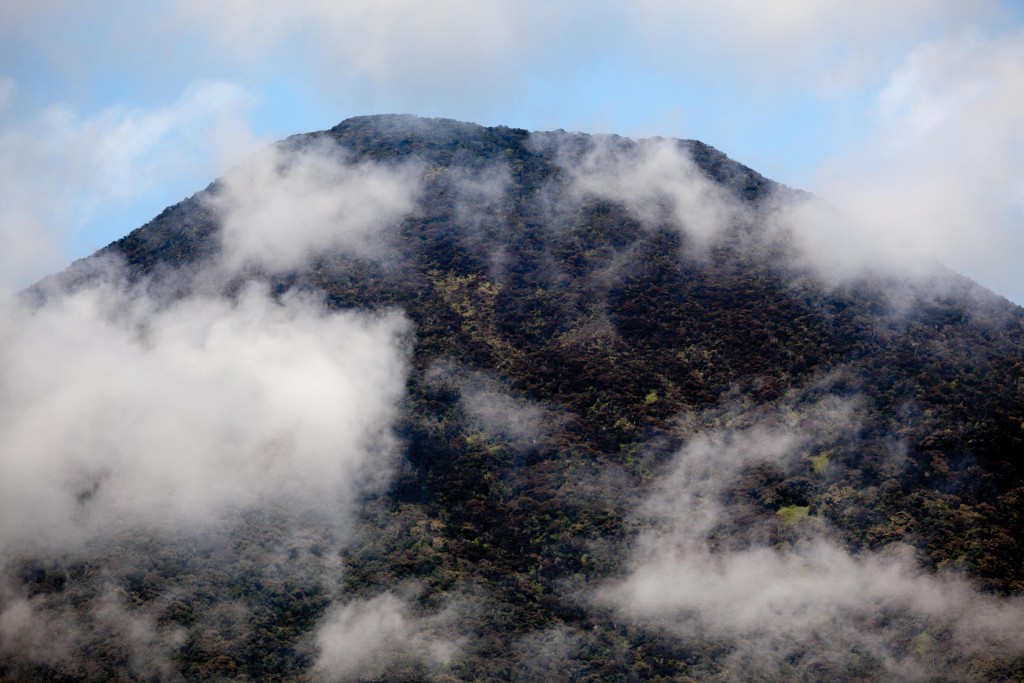
Gunung Gede / Gede Mountain
Provided you can escape Jakarta’s insane traffic (it took me 2.5 hours one evening to do a journey across town that took 10 minutes coming back), it should take three to four hours driving south to reach Gunung Gede. It’s a popular park with Indonesian tourists, and I had the misfortune to arrive on the first day of the school vacations. Numbers swelled during my stay with increasingly many, increasingly noisy, people walking through the park. Fifteen people walking the trails constantly making monkey imitations at the tops of their voices was par for the course.
I stayed at Freddy’s Homestay which is as basic as it gets, but clean and friendly. It is well known to backpackers and birdwatchers alike. Freddy’s son Eddy was my guide to Gunung Gede. His other son, Indra, was one of the people I dealt with at IF-Ecoadventure.
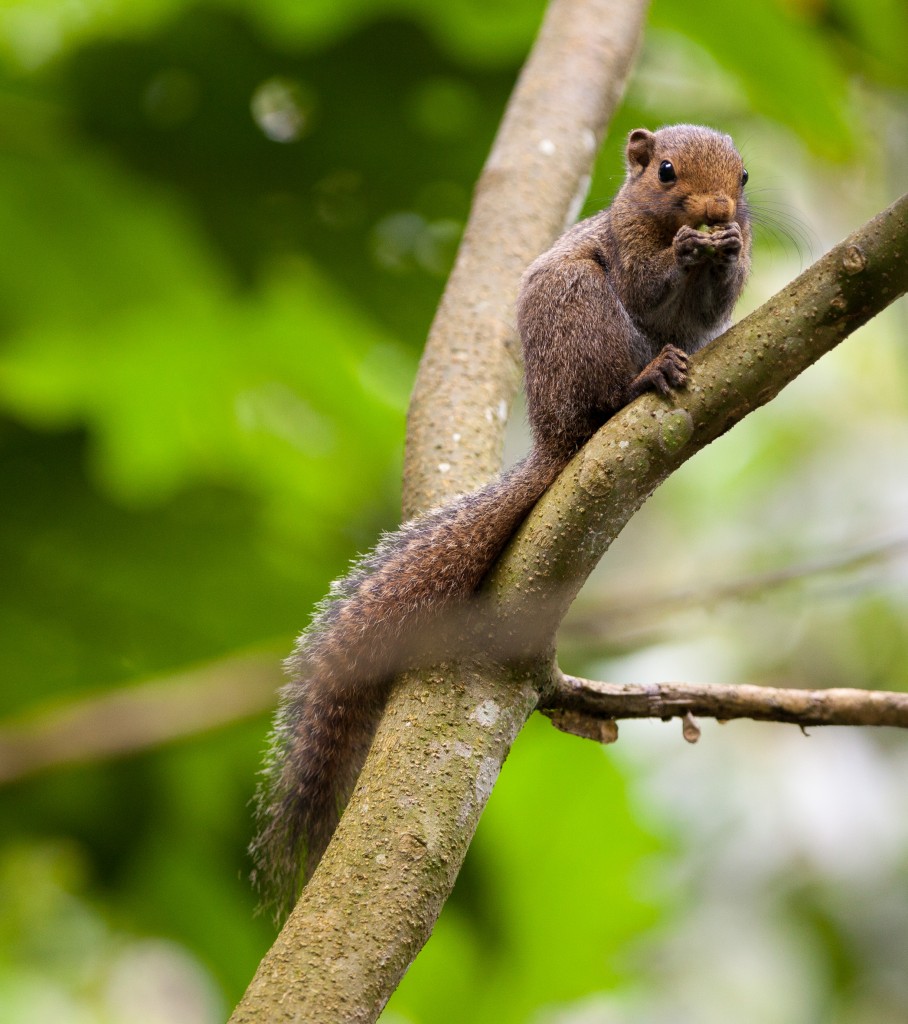
Black-striped Squirrel, Callosciurus nigrovittatus
My main targets here were Ebony (aka West Javan) and Grizzled Langurs, Javanese Ferret Badger, Javan Mongoose, Malay (or Stink) Badger and Javan Warty Pig. I was not sure that the warty pigs were actually present – no one I spoke to seemed sure whether it was this species or Wild Boar that was common in the park.
Ebony (or West Javan) Langurs were easy to find in the park. We saw them every day, usually along the first kilometre of the Waterfall Trail. They were not at all shy.
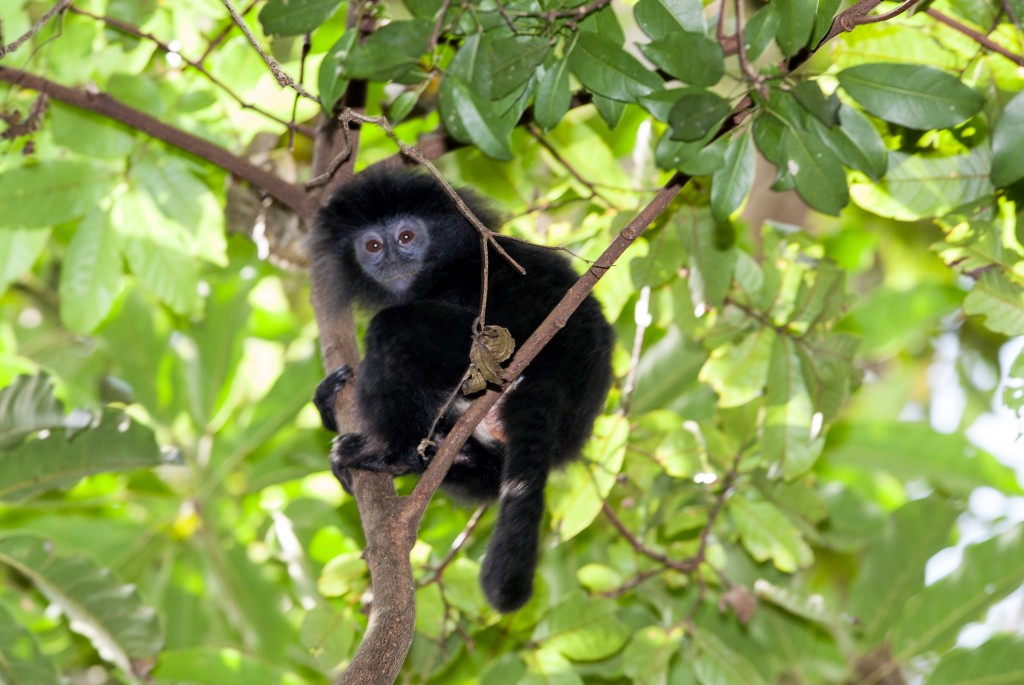
West Javan Langur, Trachypithecus mauritius
The Grizzled Langurs were much shyer. We only looked for these once, and Eddy focused on the stretch of trail around “Blue Lake”, 1.7km along the trail. We had fleeting views of a group of 10 or so at about 11 a.m. and even more fleeting views of animals in the afternoon.
Javanese Ferret Badgers seem to be quite common. We saw two juveniles on our first evening’s spotlight around Mandalawani campgrounds near the park and heard what was probably another. They are often seen around the litter bins in the park, but there were so many people on the trail, even after dark, that you would need to be a particularly tolerant – or stupid – ferret badger not to retreat to the forest.
The Javan Mongoose took a bit of tracking down. They are common around the town and in the network of market gardens around the park and golf course. We spent several hours staking out various small garbage dumps before we saw an animal raiding the main rubbish dump near Freddy’s Homestay. I later learned they are common in Jakartan suburbs. Mark Andrews saw several in the trash behind his hotel for example in 2019.
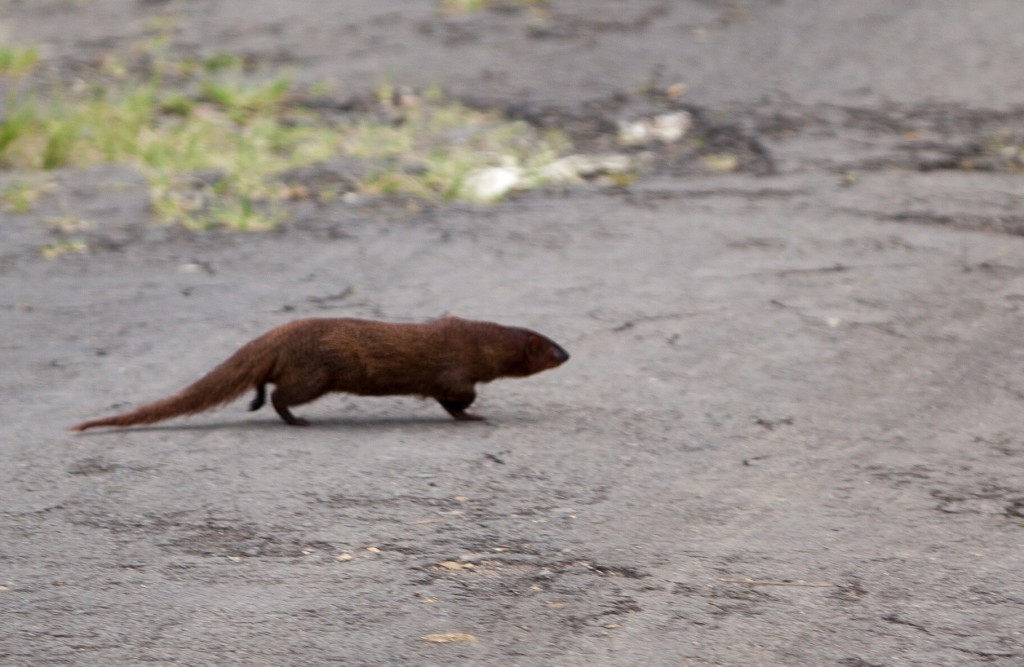
Javan Mongoose, Herpestes javanicus
There was some confusion over whether Javan Warty Pigs were present in the park. No one I asked to seemed to know the difference between warty pigs and Eurasian Wild Boar which are the other pig in Java (and this was the species reported by Tim Mitzen in his report below). It didn’t help that I had no pictures of Javan Warty Pigs and didn’t know what they looked like myself.
What was sure was that at least one species of pig was present. Eddy said pigs were common in the forest and most often seen in the market gardens abutting the park and golf course after dark. There was plenty of evidence of their presence.
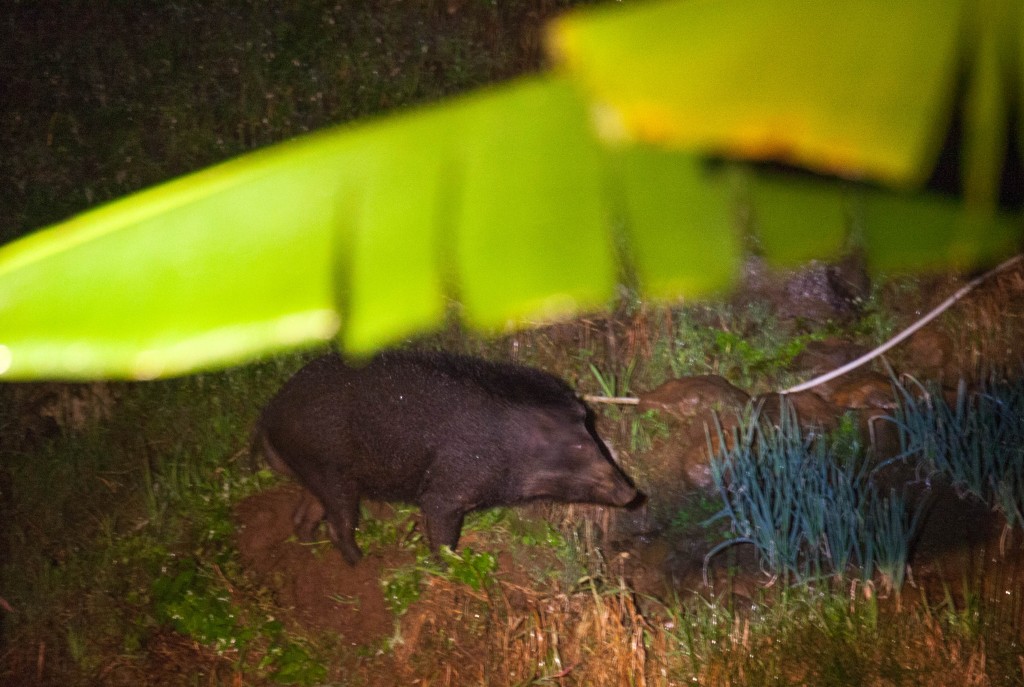
Wild Boar, Sus scrofa
We spent three wet evenings looking for them, mainly in one of the market gardens. We centred on Eddy’s recommended “Location Raspberry” (which would be a good title for a movie I reckon, perhaps a sequel to Mission Impossible and that was how I was beginning to feel during our last night of looking for them). During our penultimate evening at Location Raspberry we left the lookout rock in the raspberry patch to shelter from the rain, and an hour later returned to find new pig diggings around the rock. But as I was unconvinced the pigs were Warty ones I wasn’t particularly upset.
On our last night we returned to Location Raspberry at dusk and immediately had to take shelter from very heavy rain for over two hours. It was still raining solidly when we gave up to walk back to the motorbike. On the way back we spotted a large male pig. The heavy rain made it difficult to take photos but the animal was quite easy to approach and the pictures were good enough to show the white stripe on the animals head and some large warts on the face, both of which features I thought were diagnostic for a warty pig. Apparently not however. Although I managed to convince myself that this was a Javan Warty Pig I was contacted afterwards by Roland Wirth, a scientist, familiar with the species, who was certain it was the local vittatus subspecies of Wild Boar (Sus scrofa). Some pictures of a real Javan Warty Pig are here. Dammit! It sounds like there aren’t any warty pigs at Gede, or if there are it would be a cause for some celebration.
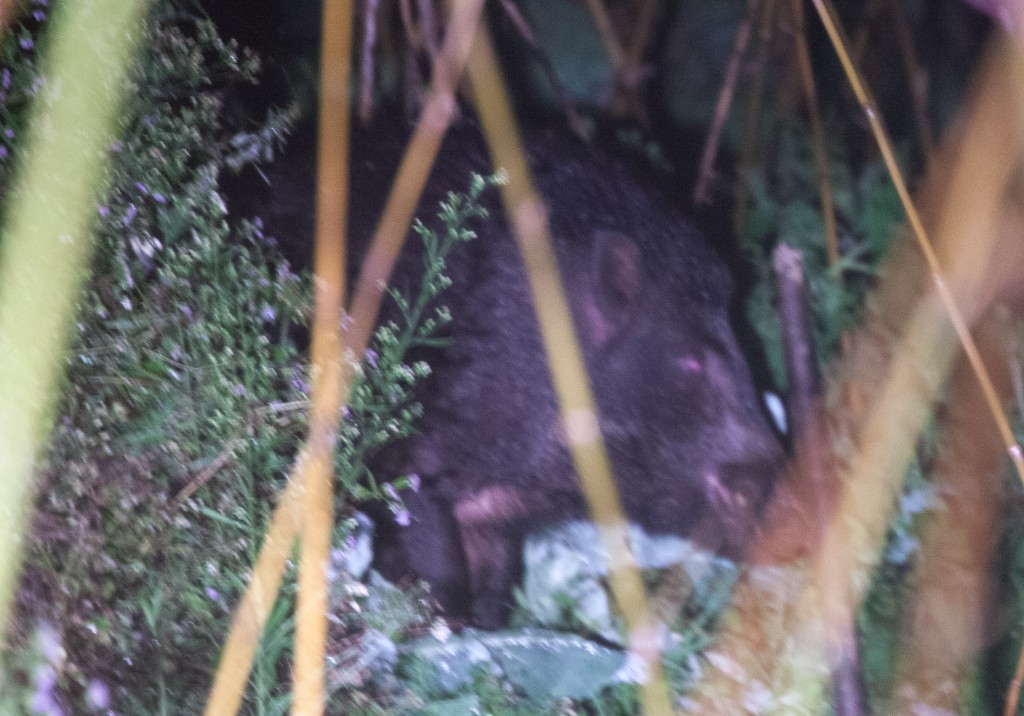
Wild Boar, Sus scrofa
Treeshrews are very common in the park and botanic gardens (with treeshrews particularly common in the smaller trees along the road that runs to the golf course and park). And for once you can get a decent look at them. I thought the treeshrew species I was seeing mainly was Tupaia glis (now split to T. hypochrysa), though I also saw what I believe to be a second smaller species (Horsfield’s Treeshrew, Tupaia javanica) in the botanic gardens. But as I didn’t have a picture of Horsfield’s Treeshrew I wasn’t sure. On reading more, according to the IUCN at least, Tupaia hyporchrusa might be out of range here while T. javanica is mentioned as occurring in Cibodas Botanical Gardens. So I suspect I saw just one species, the endemic Horsfield’s Tree Shrew.
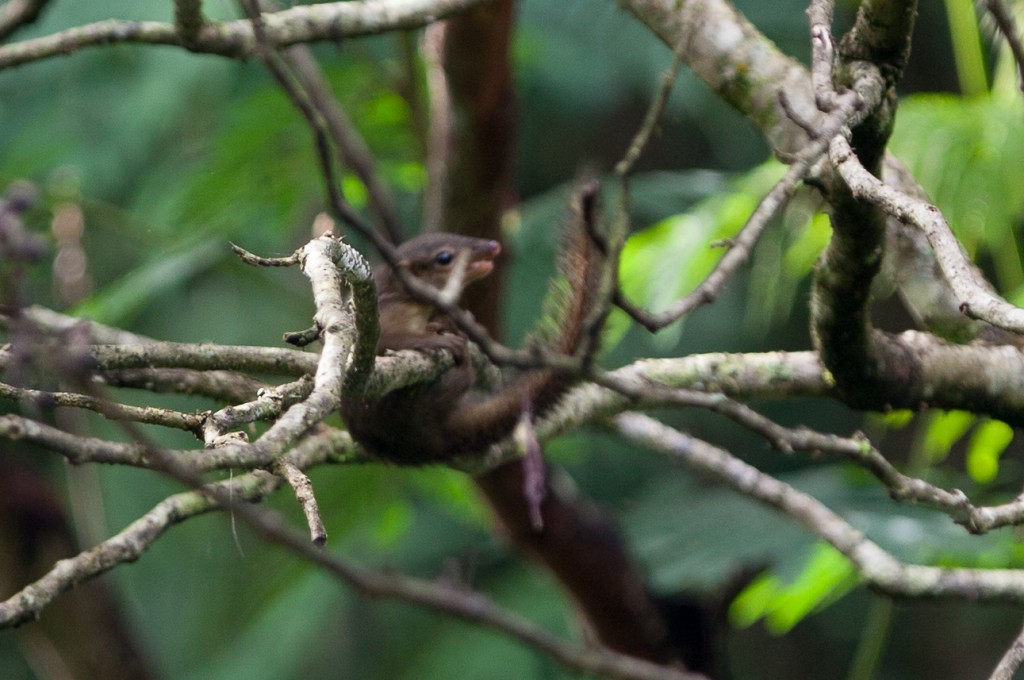
Horsfield’s (Javan) Tree-Shrew, Tupaia javanica
Squirrels are also very common in the park.
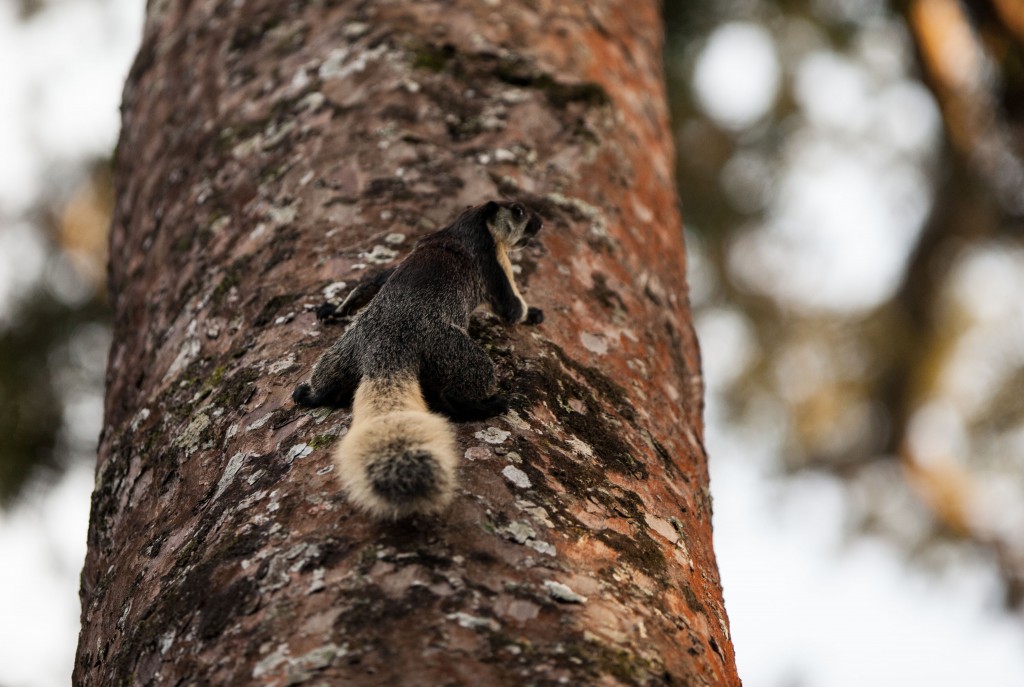
Black Giant Squirrel, Ratufa bicolor
We heard many Black Giant Squirrels at around dawn and saw one.
Sunda Black-banded (Black-striped) Squirrels were the most common species in the day time.
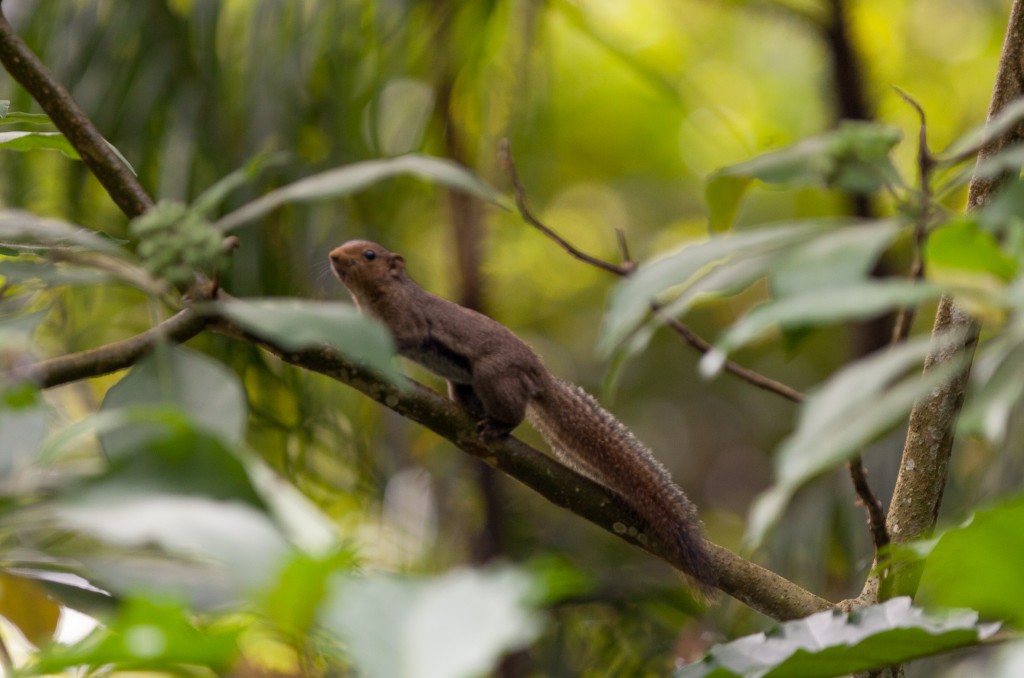
Black-striped Squirrel, Callosciurus nigrovittatus
I also saw several Three-striped Ground Squirrels.
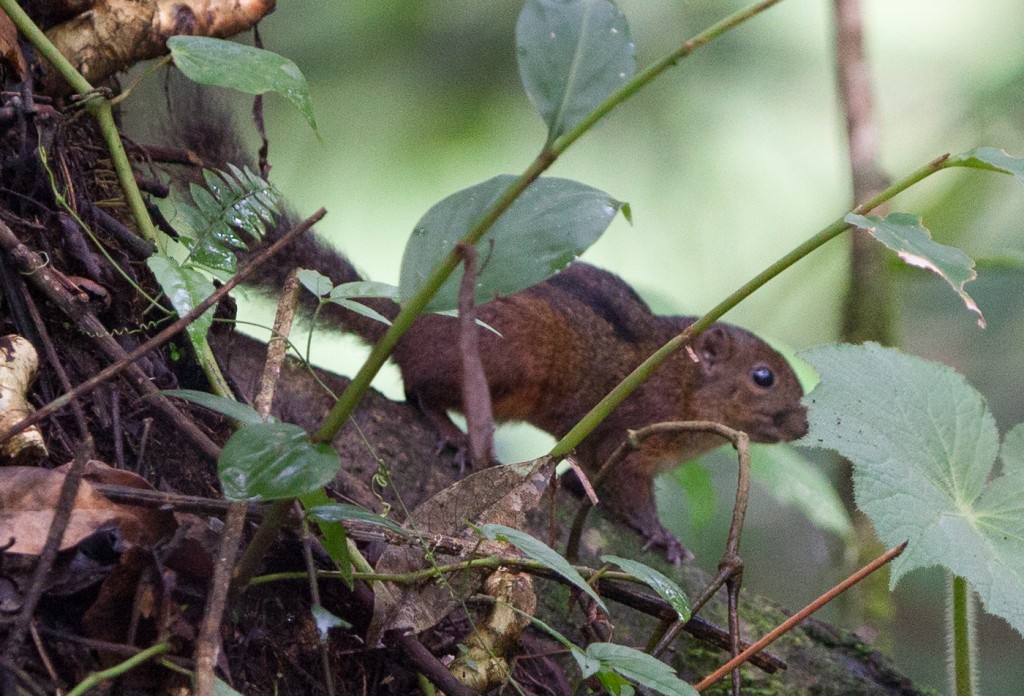
Three-striped Ground Squirrel, Lariscus insignis
There is a bat cave 2.4 km along the Waterfall Trail (it is off to the right though you would need a guide to point you to the unmarked track). A pool of water stops you entering into the cave, but it contained hundreds of bats, all apparently the same species – one of the bentwings I think, and after reading more it seems they are probably Medium Bentwings (Miniopterus medius) but I am not 100% certain.
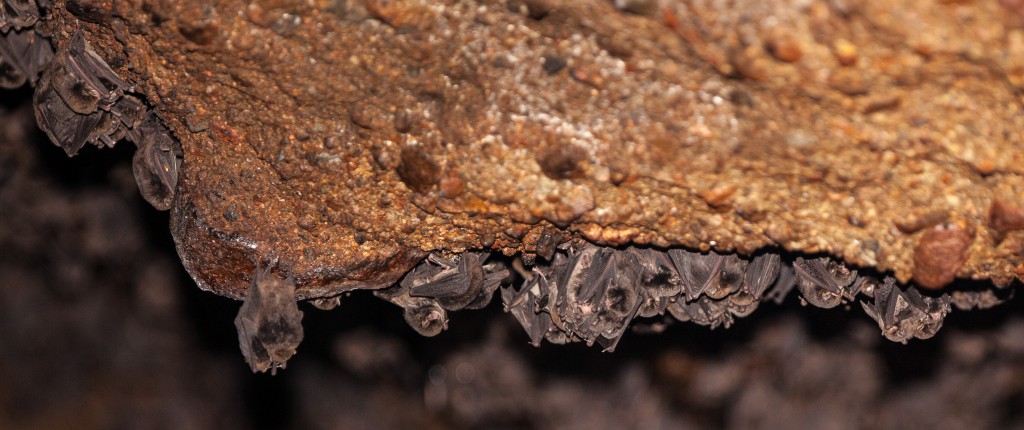
Medium Bentwings, Miniopterus medius, I think
I set a few traps but caught only two animals. I am pretty sure the first was a Niviventer Rat though it leaped out of the trap before I had a chance to measure it and could either have been N. lepturus or N. cremoriventer there. I also caught a Lesser Gymnure and saw saw another Lesser Gymnure by the Blue Lake. We also had a pair of Polynesian Rats running around a wood pile in one of the market gardens where we were sheltering from the rain. I had so much time to kill I managed to get some photos in the pitch dark by randomly photographing the patch of ground that the animals were feeding on and getting lucky one time out of five (if I tried to put a light on them they would flee).
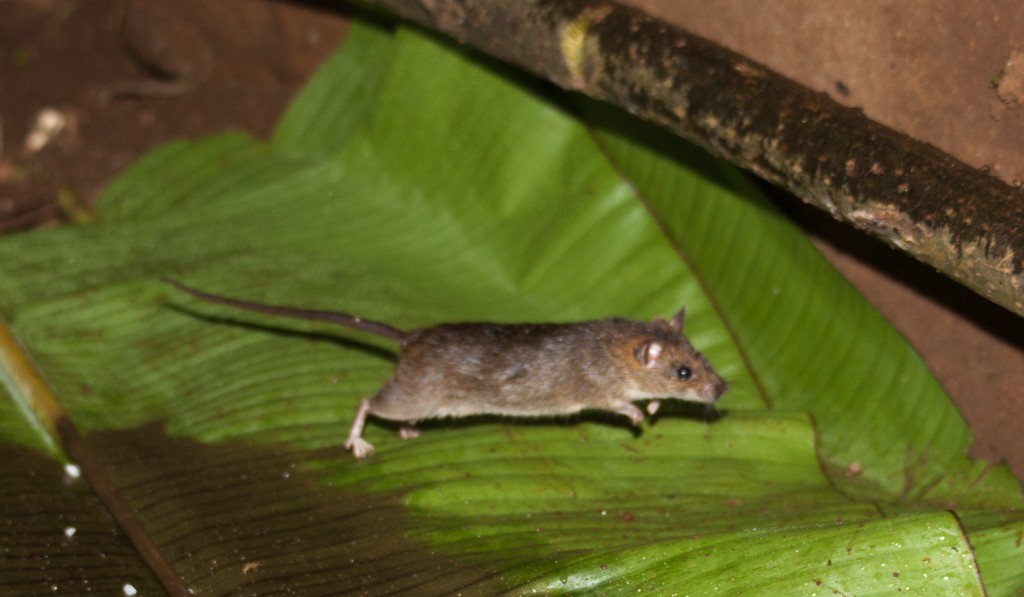
Polynesian Rat, Rattus exulans
Spotlighting around the farmland we saw a Common Palm Civet and – just before dawn – a Small Indian Civet. I saw the animal pretty well and for 20 seconds and was confident it was a Large Spotted Civet until I read that Large Spotted Civets aren’t on Java. Very strange and just goes to show how easy it is to mid-identify things.
Eddy frequently sees animals – that from his description I imagine must be Short-clawed Otters – in the Blue Lake (about a mile up the trail in the park). We looked a couple of times but he thought there were too many people using the park, though we also spent an hour looking at dawn when for once we weren’t bothered by people.
So Gunung Gede, despite its crowds, isn’t a bad place to see some of the Javan species and Eddy is very good at finding them.
Stuff I Missed
Not very much really. I saw all of the things I was looking for other than a Malaysian (Stink) Badger: Stink Badgers are apparently common and often seen, even in the day time, rooting around the rubbish near the park HQ. Eddy thought the crowds of people in the park were disturbing them too much.
It would have been nice to have got a closer look at a Javan Ferret Badger too, but though they are common there were too many people milling around the badger’s usual haunts. We returned to Mandalawani campsite on our last night where we had first seen the Ferret Badgers, but hundreds of tents had sprung up.
Javan Gibbons are also in the park but they are rare and we made no effort to see them as the species is much easier in Gunung Halimun. Pangolins and porcupines must also be present I imagine, but Eddy had never seen them so they are either rare or hard to spot.
Bartel’s Flying Squirrel (Hylopetes bartelsi), endemic to Java, is only known from this mountain, though I don’t know from what elevation or if there’s much chance of seeing one.
Halimun National Park
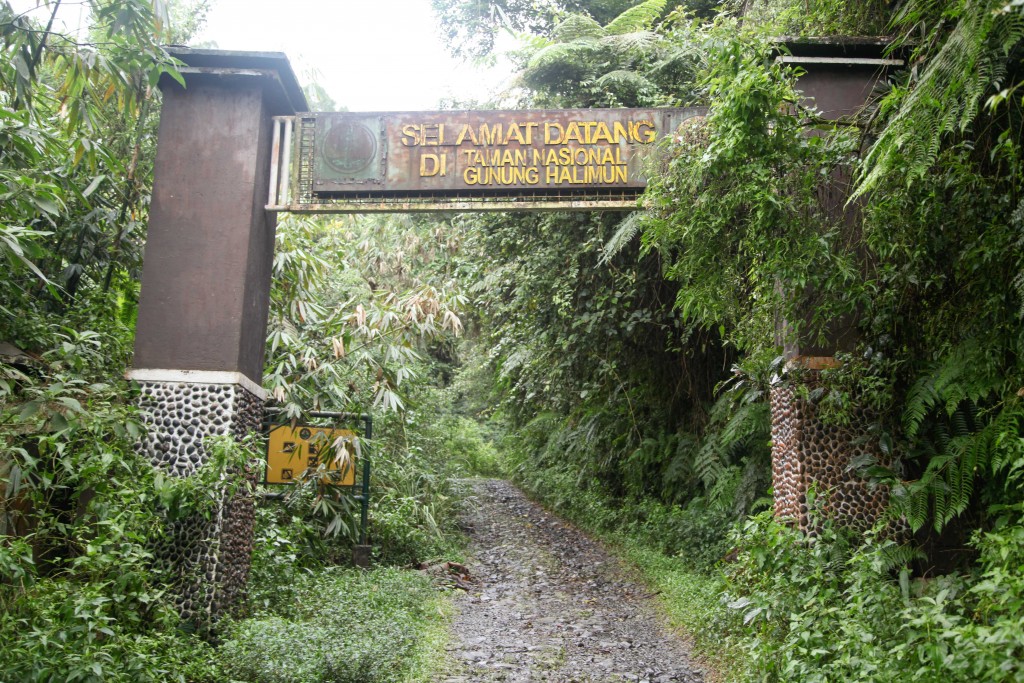
Halimun National Park is a four hour drive from Mount Gede, about two hours of which are along an extremely rugged road. The road is not so difficult to traverse. It is more the roughness of cobblestones it is constructed from. ‘Bouncy’ doesn’t quite capture it. Even I couldn’t sleep while we were driving it, which is a first. If you went faster than 10 kmh you’d detach a retina.
Few tourist visit the park and accommodation is limited to three village houses which run homestays (a now defunct website pushed the boundaries a bit when it described the houses as ecolodges).
The park comprises about 40,000 hectares of what looked like primary rainforest, with a least one small tea plantation in the middle. The research station at Cikaniki in the middle of the park is a good place to focus searching effort around, and we stayed about a kilometre (or a 15 minutes drive from here). The research station had an extremely useful book on the mammals of the park, which was a meta study of different field work. I couldn’t find a copy for sale so I jotted down the checklist of mammals here.
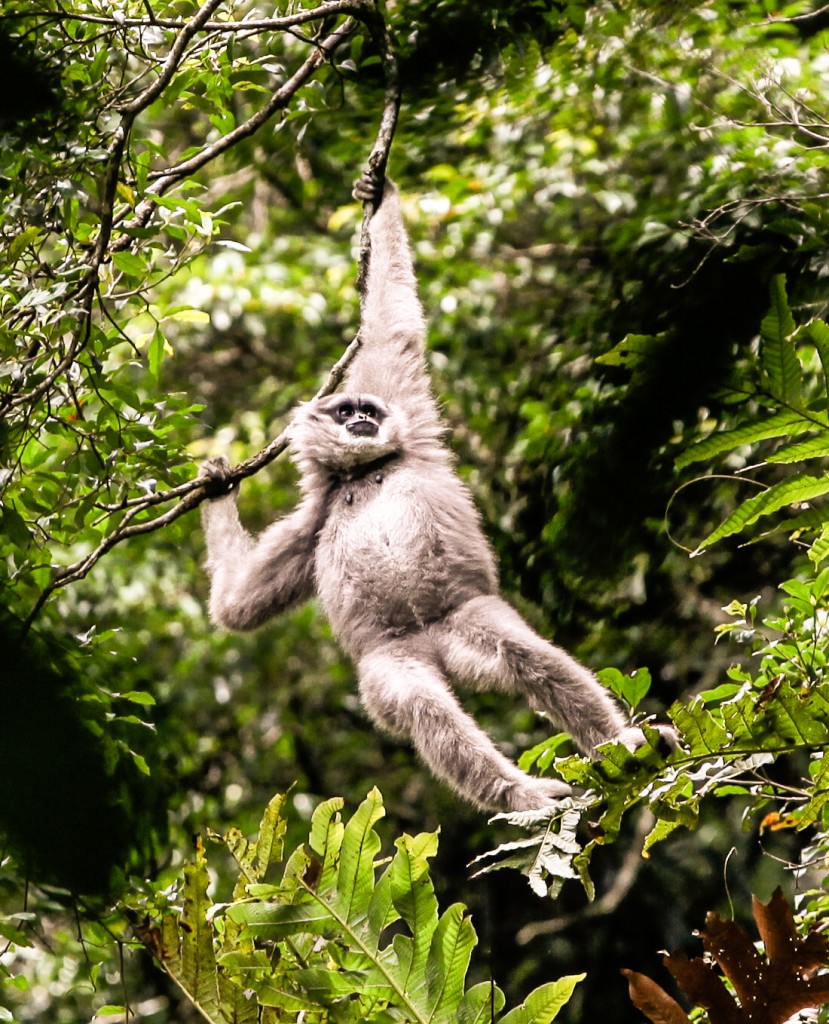
Silvery (Javan) Gibbon, Hylobates moloch
My main reason to visit was to see the Javan Gibbons and they were easy to find. We heard them at 9 a.m. when we arrived, and an hour later I walked the 2 km trail from the homestay to the research station with Ade, a local guide, and we found a group about half way along the trail at midday. Japanese and Korean researchers have been studying the animals for some time it seems, so several groups of gibbons were well habituated.
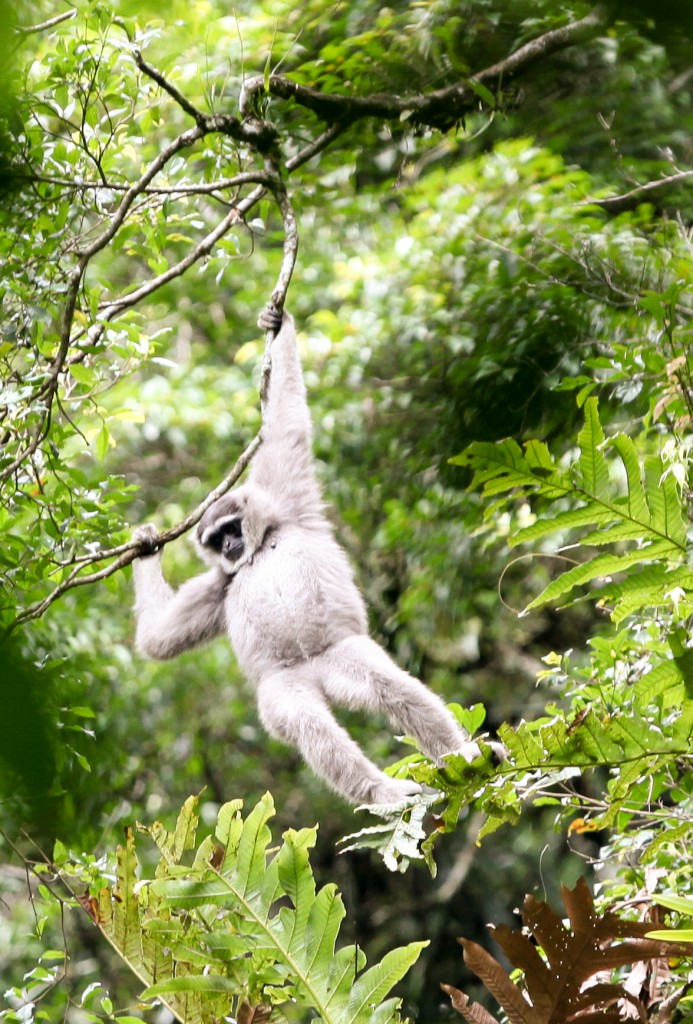
Silvery (Javan) Gibbon, Hylobates moloch
During the walk we also saw several Black-banded Squirrels, a Black Giant Squirrel and my first Black-eared Pygmy Squirrel, which, as is usually the case for a pygmy squirrel, was high up and flitting around the trunk of a very big tree, so the photo was pretty distant.
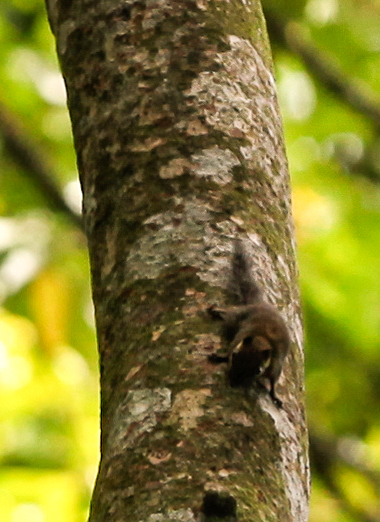
Black-eared Pygmy Squirrel, Nannosciurus melanotis
A tree next to the research station was full of fruit and at about 7 p.m. on both nights contained a Common Palm Civet and two very orange Small-toothed Palm Civets.
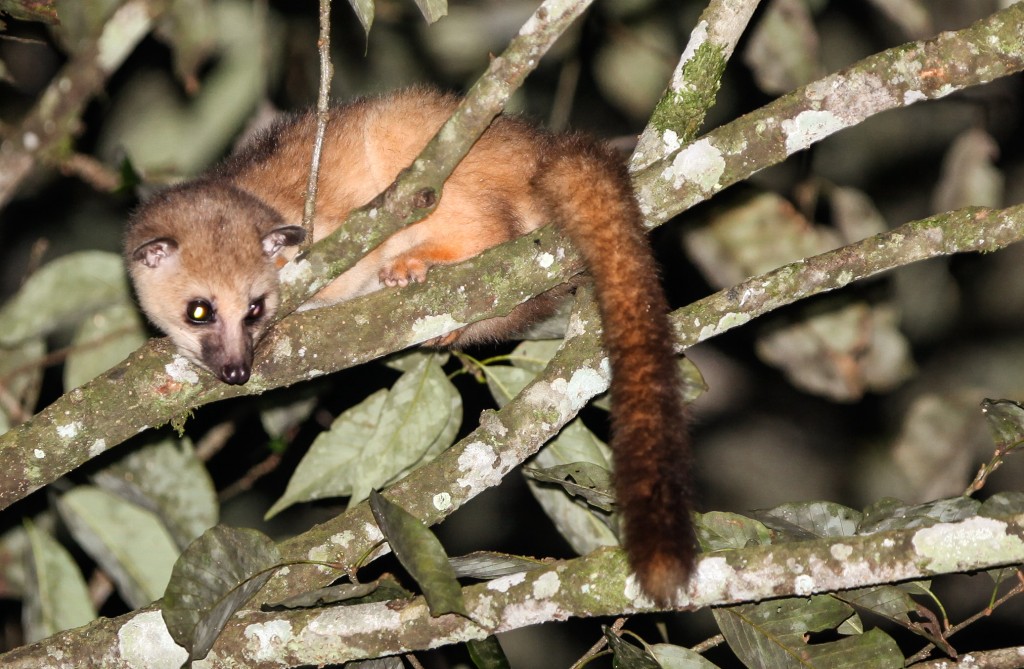
Javan Small-toothed Palm Civet, Arctogalidia trivirgata trilineata
These were indeed strangely orange. And a year or so later some small carnivore specialists stumbled on the photos here and were excited. These animals are the Javan Small Toothed Palm Civet which is almost certainly a species in its own right – Arctogalidia trilineata – and which hadn’t been recorded for many years. My sightings, along with those from James Eaton, were published in an IUCN journal.
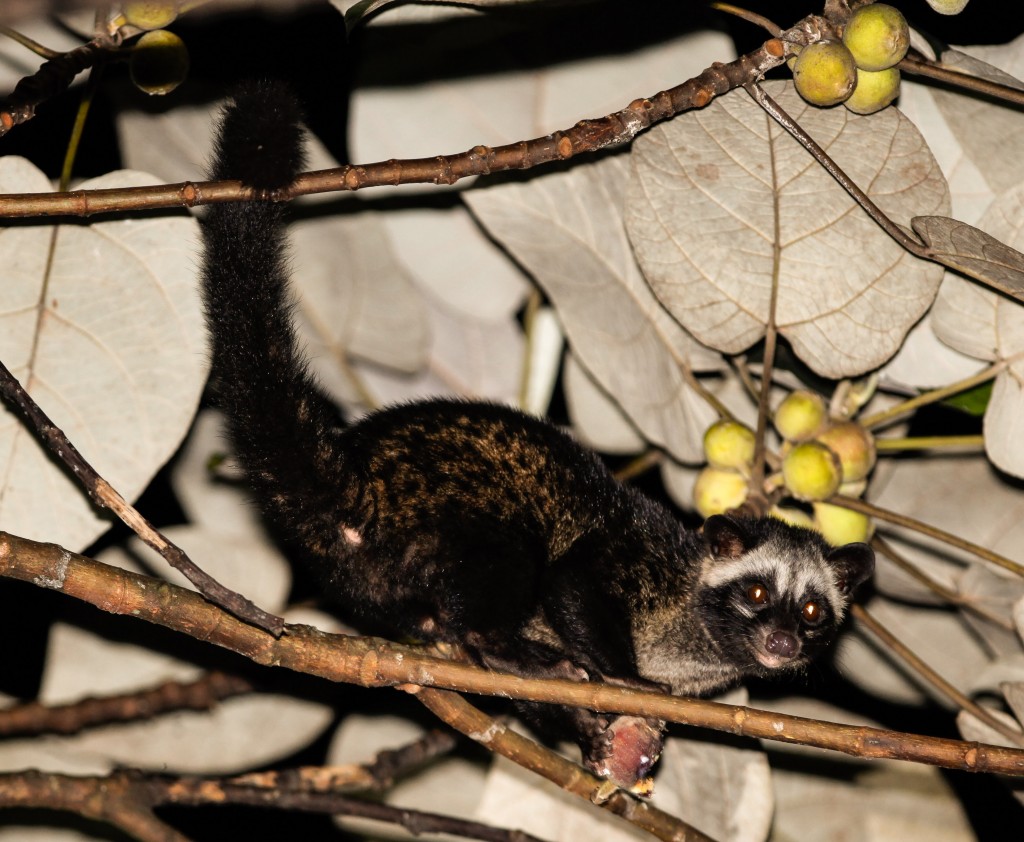
Common Palm Civet, Paradoxurus hermaphroditus
Banded Linsangs, while difficult to see here might be a bit easier than some of the other places I have been. They were often camera trapped near the research station and both Ade and Indra had seen them here. We walked the trail for 90 minutes behind the research station at 7 p.m. but didn’t see any mammals.
There was some discussion on where to look for Malay (Stink) Badgers. They might be easier to see around the villages or in the tea plantation than the park itself, although they are common in the park too. We opted to drive along the road through the park and after half an hour spotted a badger on the road. I got a very quick look at it before it hooned off into the forest. They are just fabulous little things. We had better views at 9 p.m. the following evening. Once again the animal jumped off the road as we were driving along, but it loitered in the vegetation just off the road to pose for a (bad) picture.
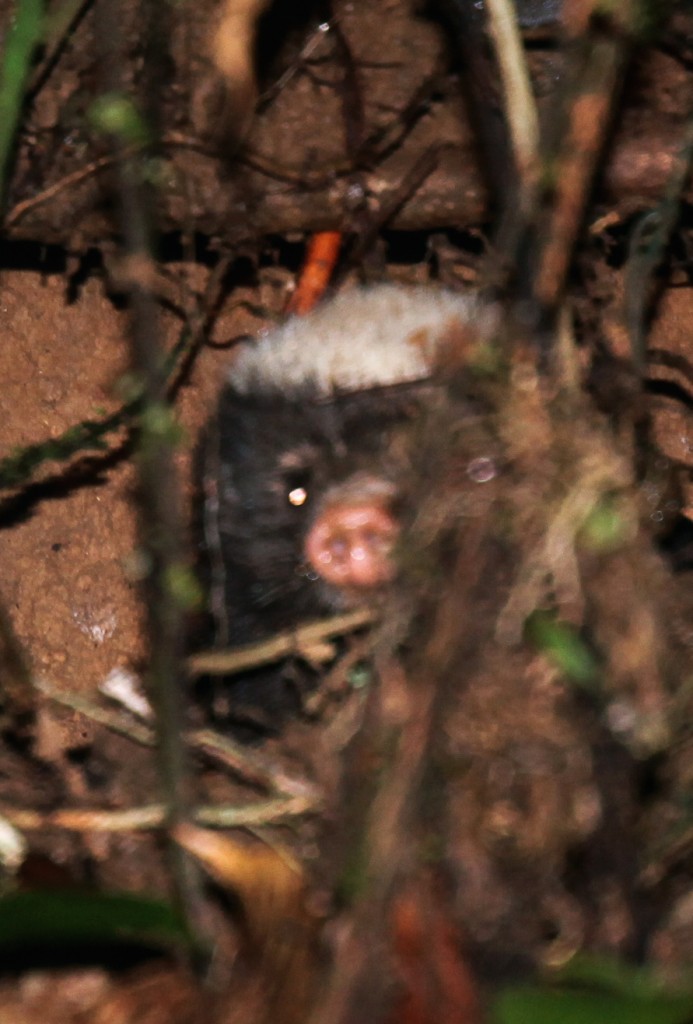
Sunda Stink Badger, Mydaus javanensis
During a two hour spotlighting walk along the road we saw a couple of Red Giant Flying Squirrels. According to the book about the park’s mammals, Lesser (Spotted) Giant Flying Squirrels are more common in the park, but try as I might I couldn’t turn either animal into anything other than a Red Giant Flying Squirrel.
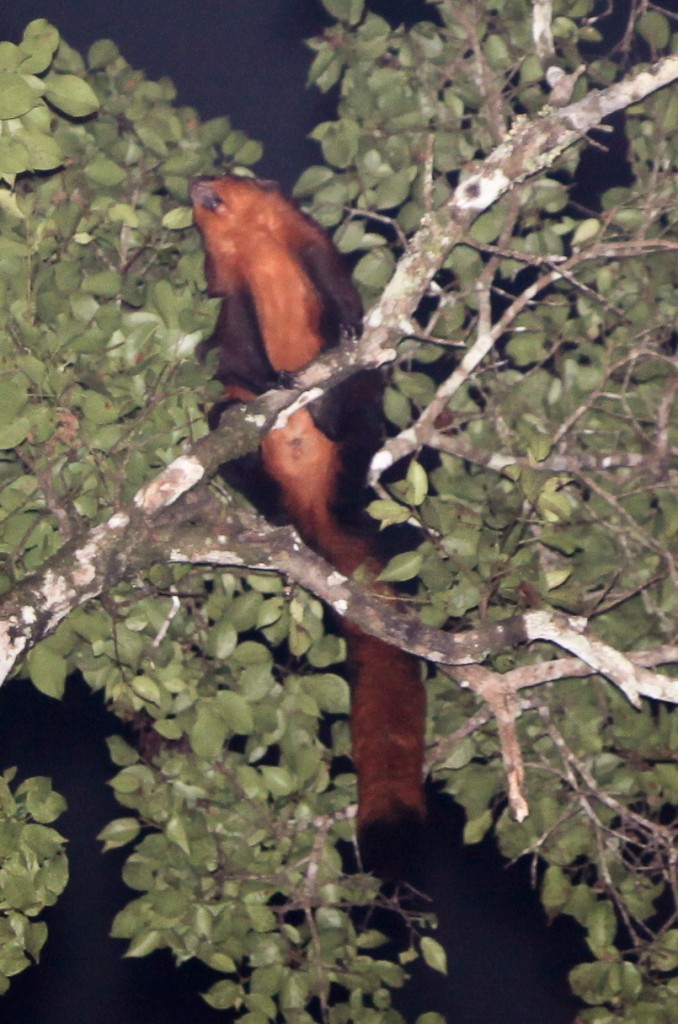
Red Giant Flying Squirrel, Petaurista petaurista
Near the park HQ we spotted a small mouse running around in a tree – my first Pencil Tailed Tree Mouse. Another tree held a couple of reddish rats with short tails that were zipping around, which I think were almost certainly Javan Sunda Spiny Rats (Maxomys Bartelsii).
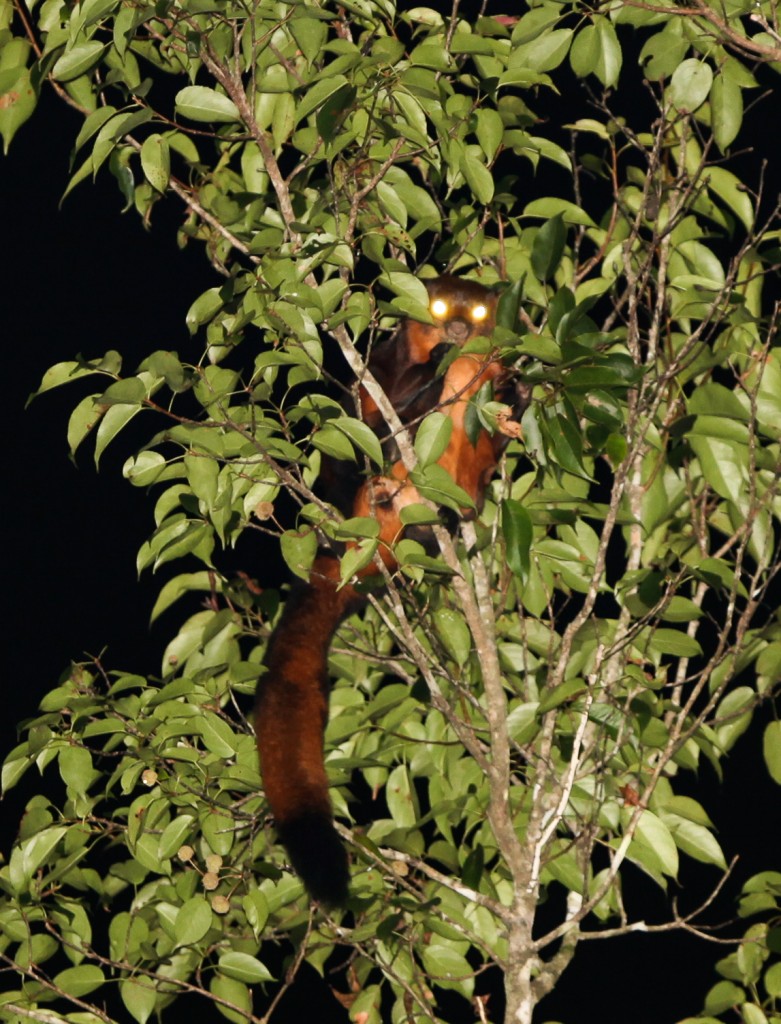
Red Giant Flying Squirrel, Petaurista petaurista
On the way back to Jakarta I had planned to stop at Bogor Botanic Gardens where fruit bats roost according to Indra. I suspect they were Cynopterus sphinx . But we were running late and the traffic is so unpredictable that I skipped the short diversion to make my flight. We didn’t skip lunch however and in a cruel twist of fate the restaurant we chose had a stuffed pangolin by the cash register! Thankfully they were not on the menu.
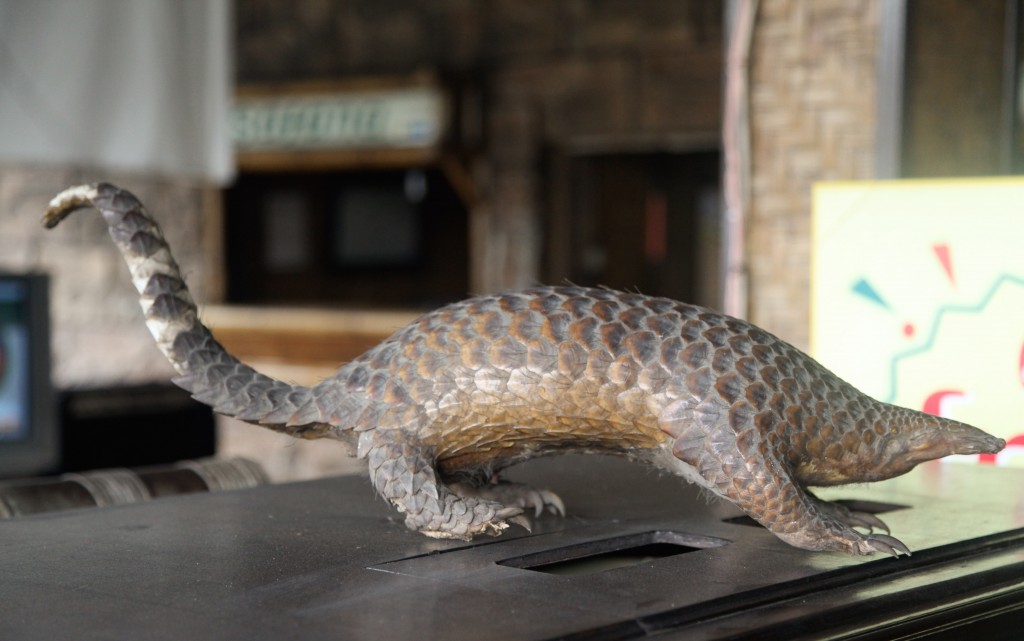
A very dead pangolin
Stuff I Missed
My main targets in Halimun were the Javan Gibbons and Stink Badgers. It would have been wonderful to have seen a Banded Linsang but it was never likely (though they do seem to be seen more often here than anywhere else I have ever been). Apparently Javan Porcupines are around and can be caught in cage traps near the research station. Lesser Giant Flying Squirrels are fairly common in the park, though perhaps at higher elevations than around the research station. Of course there are other mammals, including Leopards, but I wasn’t looking for them.
Ujung Kulon National Park
If I was spending more time in Java I would have visited Ujung Kulon National Park, a lowland rainforest west of Jakarta and the last stronghold (if 50 animals can be called strong) of the Javan Rhino. The chance to see rhinos here is small but seems better than what I expected. I spoke to a couple of people who had visited and both saw very fresh rhino tracks. Though it took a recent photographer three long weeks holed up in a hide before he could photograph an animal. The animals are immensely shy and you would need to spend at least a week there to have a chance of seeing one I imagine. Getting to the park is quite expensive and requires a five hour speedboat trip to the accommodation. Travel around the park is by canoe. Perhaps spotlighting trips by canoe would be the way to see the beast. You can also combine a visit here with a trip to Krakatoa which would be fun.
Trip List
Black Giant Squirrel Ratufa bicolor – GG & GH
Black-striped Squirrel Callosciurus nigrovittatus – GG & GH
F Three-striped Ground Squirrel Lariscus insignis – GG
F Black-eared Squirrel Nannosciurus melanotis – GH
Red Giant Flying Squirrel Petaurista petaurista – GH
F Common Pencil-tailed Tree Mouse Chiropodomys gliroides – GH
Polynesian Rat Rattus exulans – GG
F Bartels’ Spiny Rat Maxomys bartelsii – GH
White-bellied Rat Niviventer lepturus/cremoriventer – GG
Small Indian Civet Viverricula indica – GG
Asian Palm Civet Paradoxurus hermaphroditus – GG & GH
Javan Small-toothed Palm Civet Arctogalidia trivirgata trilineata – GH
F Javan Mongoose Herpestes javanicus – GG
F Sunda Stink Badger Mydaus javanensis – GH
F Javan Ferret-Badger Melogale orientalis – GG
Lesser Gymnure Hylomys suillus – GG
F Grizzled Leaf Monkey Presbytis comata – GG
F West Javan Langur Trachypithecus mauritius- GG
F Silvery Gibbon Hylobates moloch – GH
F Javan Tree-Shrew Tupaia javanica – GG
Wild Pig Sus scrofa – GG
F Medium Bentwing Miniopterus medius TBC – GG
22 SPECIES
GG – Gunung Gede
GH – Gunung Halimun
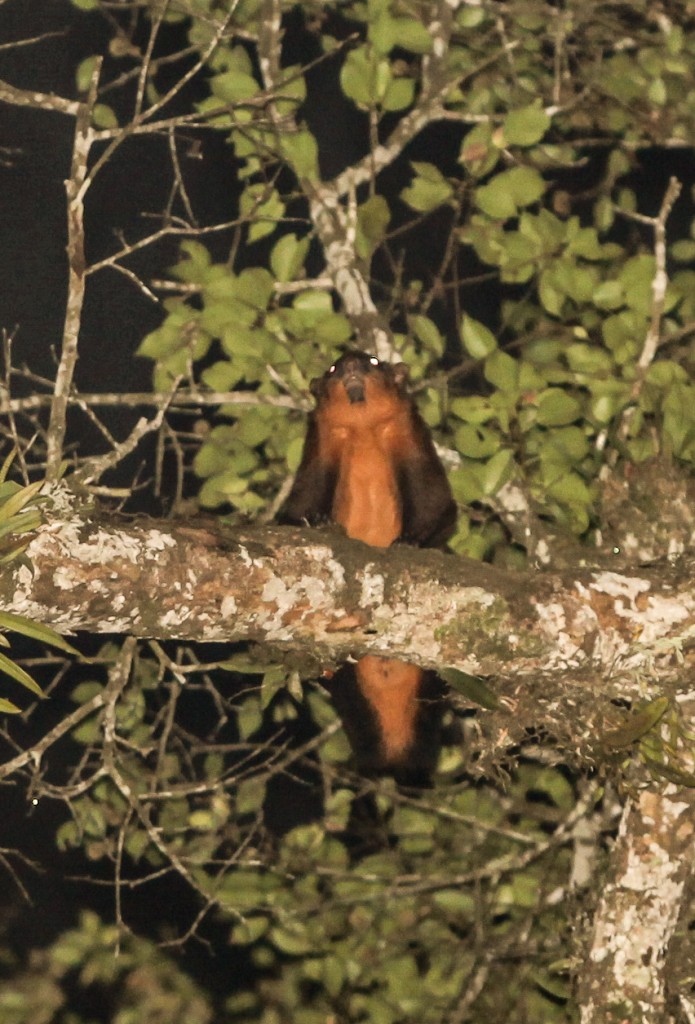
Red Giant Flying Squirrel, Petaurista petaurista


Leave a Reply
You must be logged in to post a comment.